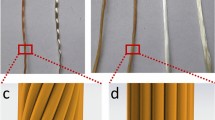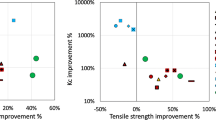Abstract
GORDON and Jeronimidis1 and Atkins2 have noted that increased fracture toughness in fibrous composites can be obtained by an enhanced decoupling of the fibre–matrix interface. Gordon1 has pointed out that in the case of wood (natural cellulose), the decoupling of the ‘reinforcing elements’ from the rest of the structure is stress dependent and the cells in the vicinity of the fracture face can extend by about 20 per cent before breaking, absorbing a great deal of energy in the process. The failing strain of the material as a whole is, however, about 1%. Atkins2 pointed out that increased wdrks of fracture can be obtained in boron fibre expoxy resin composites by arranging for a distribution of strongly and weakly bonded interfacial regions along the fibres. During crack propagation the weakly bonded regions allow greater lengths of fractured fibres to be pulled out of the matrix with a concomitant increase in the work of fracture. The tensile strength of the composite system is not affected significantly but the overall failing strain is again limited by the failing strain of the reinforcing fibres to about 1%.
This is a preview of subscription content, access via your institution
Access options
Subscribe to this journal
Receive 51 print issues and online access
$199.00 per year
only $3.90 per issue
Buy this article
- Purchase on Springer Link
- Instant access to full article PDF
Prices may be subject to local taxes which are calculated during checkout
Similar content being viewed by others
References
Gordon, J. E., and Jeronimidis, G., Nature, 252, 116 (1974).
Atkins, A. G., Nature, 252, 116–118 (1974).
Morley, J. G., Proc. R. Soc., A 319, 117–126 (1970).
Morley, J. G., Composites, 2 (2), 80–84 (1971).
Morley, J. G., 23rd Int. Congr. pure appl. Chem., 8, 311–317 (1971).
Morley, J. G. Properties of Fibre Composites, Conference Proceedings, National Physical Laboratory, 33–35 (IPC Science and Technology Press, London, 1971).
Morley, J. G., and Millman, R. S., J. Mater. Sci., 9, 1171–1182 (1974).
Morley, J. G., Discuss. Faraday Soc., 2, 109–116 (1972).
Morley, J. G. in The Microstructure and Design of Alloys. Proc. 3rd int. Conf. Strength of Metals and Alloys, 232–236 (Cambridge, 1973).
Morley, J. G., and McColl, I. R., J. appl. Phys., J. Phys. D., 8 1, 15–33 (1975).
Morley, J. G., Chem. Br., 10 (12) (1974).
Chappell, M. J., add Millman, R. S., J. Mater. Sci., 9, 1933–1948 (1974).
Author information
Authors and Affiliations
Rights and permissions
About this article
Cite this article
MORLEY, J. Tough fibrous composites. Nature 254, 323–324 (1975). https://doi.org/10.1038/254323a0
Received:
Issue Date:
DOI: https://doi.org/10.1038/254323a0
Comments
By submitting a comment you agree to abide by our Terms and Community Guidelines. If you find something abusive or that does not comply with our terms or guidelines please flag it as inappropriate.



